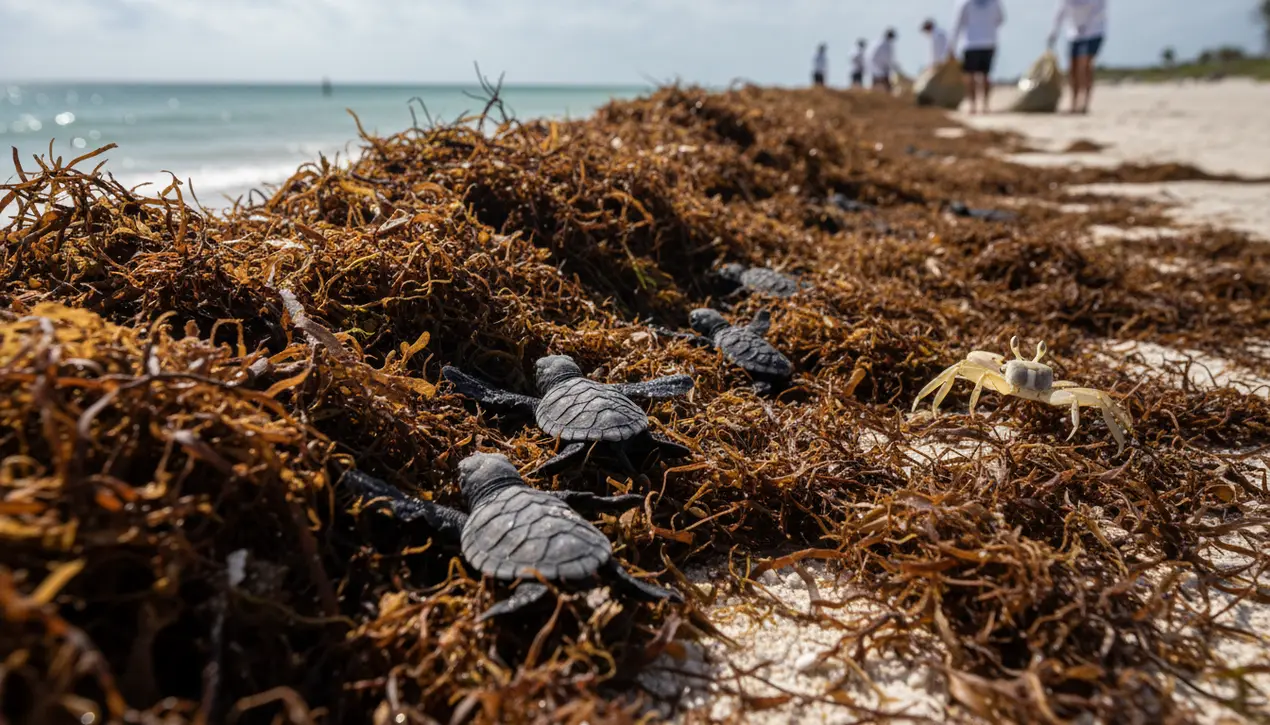
SciencebiologyMarine Biology
Sea Turtle Hatchlings Face Perilous Gauntlet as Record Sargassum Chokes Florida Beaches
RA
Rachel Adams
22 hours ago7 min read2 comments
A critical threat is emerging on Florida's coastlines, where unprecedented piles of sargassum seaweed are forming deadly obstacles for vulnerable sea turtle hatchlings. This natural journey from nest to ocean has become a treacherous marathon, with the safety of the open water often blocked by miles of tangled, decaying biomass.Under the cloak of darkness, hatchlings no larger than a palm emerge and instinctively scramble toward the water's reflective glow. Their trek, already dangerous, is now an exhausting struggle through dense, mucky mats that drastically hinder their progress.The immediate physical strain is evident as their tiny flippers churn slowly through the vegetation, but the greater dangers are the prolonged exposure to predators like raccoons and ghost crabs, and the rising sun, which can fatally overheat the reptiles if they fail to reach the cooling waves in time. Compelling research, including studies from the University of Florida, indicates that the hatchlings' energy reserves remain surprisingly stable during this hindered crawl.This pivotal discovery reframes the crisis: the primary killer is not exhaustion from the effort, but the fatal delay caused by the seaweed itself. Every minute spent trapped is a minute of heightened vulnerability.This is not an isolated incident but a symptom of a larger ecological shift. The Great Atlantic Sargassum Belt, a colossal 5,000-mile-long macroalgal bloom, has been expanding exponentially in the mid-Atlantic.Its growth is fueled by a combination of climate change, rising sea temperatures, and nutrient pollution from agricultural fertilizers entering the ocean via major rivers like the Amazon and Mississippi. Historically, sargassum formed a vital floating ecosystem in the Sargasso Sea, serving as a nursery for fish and shelter for young turtles.However, this new, hyper-abundant seaweed is a different entity, washing ashore in suffocating quantities that smother nests and reshape the beach. Veteran marine biologists with over thirty years of experience describe the current situation as unprecedented.They report that species like the loggerhead and the endangered green turtle are confronting a compounded threat during a critical life cycle bottleneck. In response, conservation groups have adapted, with volunteers now conducting 'sargassum patrols' to manually clear narrow pathways for the hatchlings—a labor-intensive and often reactive solution.The long-term implications are alarming. A significant drop in hatchling survival rates could undermine decades of recovery efforts for these ancient mariners, whose populations are already stressed by coastal development, plastic pollution, and fishing bycatch. The sargassum invasion, therefore, is more than a foul-smelling inconvenience for beachgoers; it is a stark, tangible indicator of the profound vulnerability and interconnectedness of our marine systems, a brown tide signaling a deep imbalance in planetary health.
#featured
#sargassum
#sea turtles
#hatchlings
#Florida beaches
#marine conservation
#wildlife threat
Stay Informed. Act Smarter.
Get weekly highlights, major headlines, and expert insights — then put your knowledge to work in our live prediction markets.
Related News
Comments
Loading comments...
© 2025 Outpoll Service LTD. All rights reserved.